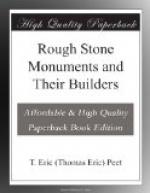To the long barrows of England answer in part at least the chambered cairns of Caithness and the Orkneys. The best known type is a long rectangular horned cairn (Fig. 4), of which there are two fine examples near Yarhouse. The largest is 240 feet in length. The chamber is circular, and roofed partly by corbelling and partly by a large slab. In the cairn of Get we have a shorter and wider example of the horned type. Another type is circular or elliptical. In a cairn of this sort at Canister an iron knife was found. On the Holm of Papa-Westra in the Orkneys there is an elliptical cairn of this kind containing a long rectangular chamber running along its major axis with seven small circular niches opening off it. The entrance passage lies on the minor axis of the barrow.
[Illustration: FIG. 4. Horned tumulus at
Garrywhin, Caithness.
(After
Montelius.)]
The megalithic monuments of Ireland are extremely numerous, and are found in almost every part of the country. They offer a particular interest from the fact that though they are of few different types they display all the stages by which the more complex were developed from the more simple. It must be remembered that most if not all the monuments we shall describe were originally covered by mounds of earth, though in most cases these have disappeared.
The simple dolmen is found in almost all parts of the country. Its single cover-slab is supported by a varying number of uprights, sometimes as few as three, oftener four or more. It is of great importance to notice the fact that here in Ireland, as elsewhere in the megalithic area, e.g. Sardinia, we have the round and rectangular dolmens in juxtaposition (Fig. 5, a and c).
[Illustration: FIG. 5. Type-plans of (a)
the round dolmen;
(b)
the dolmen with portico;
(c)
the rectangular dolmen.]
Occasionally one of the end-blocks of the dolmen instead of just closing up the space between the two nearest side-blocks is pushed back between them so as to form with them a small three-sided portico outside the chamber, but still under the shelter of the cover-slab (Fig. 5, b). A good example of this exists at Gaulstown, Waterford, where a table-stone weighing 6 tons rests on six uprights, three of which form the little portico just described. The famous dolmen of Carrickglass, Sligo, is a still more developed example of this type. Here the chamber is an accurate rectangle, and the portico is formed by adding two side-slabs outside one of the end-slabs, but still under the cover. This last is a remarkable block of limestone weighing about 70 tons. This form of tomb is without doubt a link between the simple dolmen and the corridor-tomb. The portico was at first built under the slab by pushing an end-stone inwards. Then external side-stones formed the portico, though still under the slab. The next




